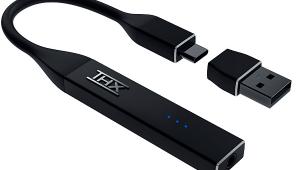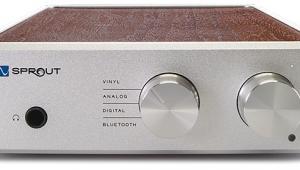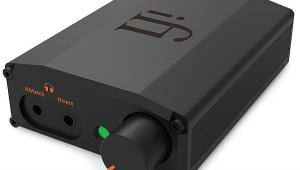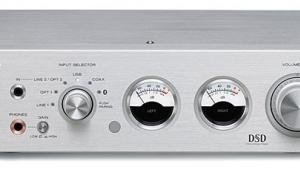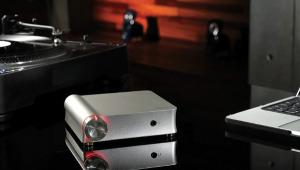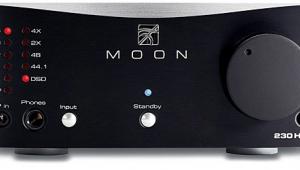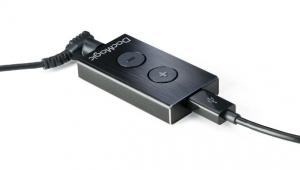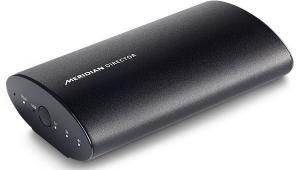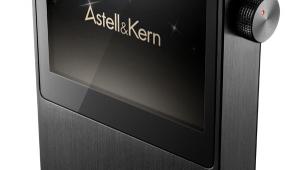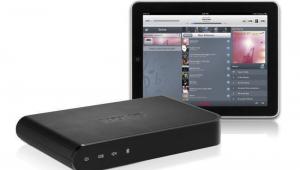Mini Amp Review: Fiio E6, Fireye Mini, GoVibe Mini Box Page 2
Fiio E6 ($49)
The E6 runs against the ethos of the typical mini headphone amp. Where the others I tested offer no controls whatsoever, the E6 has a volume control and an on/off switch that also activates three EQ modes and a high-output mode. EQ1 mode boosts bass and cuts treble; EQ2 mode just boosts bass; and EQ3 mode is described in the printed version of the manual (not the online version) as the “high-gain” mode.
It’s just one of several Fiio mini amps available, and you can get it on Amazon for less than $30. It measures 1.6 by 1.6 by 0.36 inches. A detachable plastic clip attaches it to your clothing or a shoulder strap, and you can also attach it to a keyring.
A tiny LED indicator makes it easy to select the mode you want (if, in fact, you actually want any of the modes). To me, though, the E6’s controls felt flimsy, and I didn’t find them particularly useful.
In my subjective testing, the E6 sounded pretty good. In its normal listening mode, it gave me the least perceived bass, but the overall balance still sounded natural — in fact, I found it the most subjectively pleasing of the bunch. The treble wasn’t as crystal-clear as with the GoVibe amp, but it still sounded subjectively flat and neutral, and far clearer than with my phone alone.
Where the E6 gains an advantage over its competitors is in EQ2 mode, which leaves the treble and most of the midrange alone, but pumps up the low bass. Oftentimes, IEMs deliver weak bass, whether it’s due to a poor seal of the headphone tip in your ear or a flaw in the product’s design. The E6’s EQ2 mode gives you just the right amount of bass boost to give you a good bottom-end boost without making the bass sound boomy or hyped-up. When I played Led Zeppelin or Mötley Crüe, the extra bass sounded just right — and the boost is low enough in frequency that it didn’t mess up the balance for lighter pop and jazz fare.
For my taste (and, IMHO, that of any halfway-discerning listener), EQ1 mode is useless. It just makes the sound dull and bloated, as if it were coming from a two-way speaker that had the tweeter disconnected. EQ3 mode was also useless. Instead of raising the gain, it seemed to cut the gain. Neither my ears nor my test gear could discern the purpose of this mode.
Frequency response, measured into a 32-ohm load at 1 mW (0.178 volts RMS), veered from flat, dropping -0.81 dB at 20 Hz and -0.45 dB at 20 kHz. Maximum output at 1 kHz into a 32-ohm load with 1% total harmonic distortion plus noise (THD+N) is the highest by far, at 358.3 mW in normal mode, 363.7 mW in high-gain mode. However, into a 250-ohm load, it drops into second place. Maximum gain at 1 kHz is +8.0 dB in normal mode (the highest result of the amps tested), but just +2.4 dB in EQ3 (high-gain) mode. A-weighted signal-to-noise ratio at 1 kHz in normal mode is -92.6 dB. Output impedance at 1 kHz is surprisingly low at 1.6 ohms. EQ2, the only of the EQ modes I found usable, kicks up the lows by +4.8 dB at 80 Hz. EQ1 mode keeps the bass boost but adds a treble rolloff of -4.0 dB at 20 kHz.
Although I didn’t much care for the form factor and plasticky build quality of the Fiio E6, and I prefer a mini headphone amp without controls, I have to say that this amp sounds quite good and that its EQ2 mode is definitely useful for IEMs.
- Log in or register to post comments
